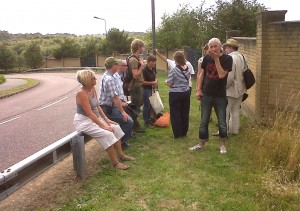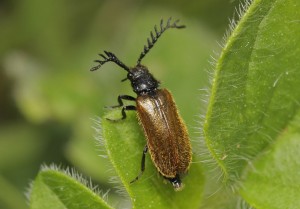London Wildlife Trust has now begun work at the fabulous Braeburn Park (aka Old Orchard/Gun Club) site on the other side of the railway line from Hall Place and Crayford Rough, and just up the road from Crayford railway station. Rich in wildlife, some of it rare in Bexley or London as a whole, the area appears to be a mystery to even the most ardent nature-lovers in the Borough, but this will hopefully begin to change soon.
A party of LWT staff, new volunteers, Councillors, Council Officers, English Nature and Bexley Natural Environment Forum representatives toured the site yesterday afternoon (July 30th) to hear more about the challenges and plans for management of this former quarry and landfill location.

Braeburn tour participants included former Bexley Biodiversity Officer John Archer (second left), Parks, Open Spaces and Nature Conservation Officer Mark Taylor (third left) and LWT’s head of Planning and Policy Mathew Frith (second right), seen here looking at the location of the geological SSSI by the housing estate access road. (Photo: Chris Rose)
The biggest hurdle to date has been the 15 year struggle to overcome the liability issues arising from the previous site uses, such as ground contamination, a problem eventually solved by the Land Trust – which has expertise in this regard – taking over ownership, and appointing LWT to do the day-to-day work.
The Braeburn Park site runs up the south slope of the Cray valley, then down the back and round a new housing estate to the Dartford Borough/Kent border. It grades from scrub, uphill into secondary Oak woodland and Hazel coppice – one path running through a phenomenally deep ravine – then sandy Broom-dotted slopes surrounding the new housing estate, with more woodland and a large bund screening industrial facilities by the old A2. A geological SSSI occurs in one corner, where quarrying has exposed various rock strata. The total area is some 25 hectares. There are fine views across the valley floor to the north slope, with Bexleyheath town centre sitting atop it in the distance.
One of the beauties of Braeburn is the close proximity of sandy, acid soil, and chalk influences, reflected in the flora, which includes Hare’sfoot Clover (Trifolium arvense), Wild Basil (Clinopodium vulgare), Wild Marjoram (Origanum vulgare), Hairy St John’s-wort (Hypericum hirsutum), Narrow-leaved Bird’s-foot Trefoil (Lotus glaber), Vervain (Verbena officinalis), Hemp agrimony (Eupatoria cannabina), Upright Hedge-parsley (Torilis japonica), Three-veined sandwort (Moehringia trinervia) and Black Bryony (Tamus communis). Here and there garden throw-outs such as Bearded Iris, Crocosmia and even Bergenia can be spotted. Only recently BNEF’s Chris Rose found Long-stalked Crane’s-bill (Geranium columbinum), currently the only known site for it in the Borough.
Bare areas of ground, including a sand pit, help make the site important for burrowing insects and those that enjoy the heat. Various notable species occur such as Drilus flavescens, quite a scarce beetle, found largely on chalk grasslands in southern England and also brownfield in the Thames Gateway area.

Drilus flavescens, an uncommon beetle, is an indicator of the importance of Braeburn Park – and brownfield sites – for invertebrates. (Photo: Tristan Bantock).
Slow Worms and Common Lizards abound, whilst significant areas of scrub attract a host of smaller bird species including Song Thrushes, Lesser Whitethroat, Whitethroat, Blackcap, Goldfinches and Greenfinches. A Kestrel is occasionally seen. There is a report of a Bullfinch, now rarely seen in the Borough, being heard here lately. Rabbits have helped keep some areas more open.
LWT’s site manager Shaun Marriott will be at Braeburn 3 days a week, and has already started work, with locals Richard and Graham, a couple of early volunteers, on creating steps up steeper sections of paths, and dealing with Bramble stems encroaching across many of the tracks. There will be plenty of opportunities to get involved with this site, including at weekends. Details should be available on BexleyWildlife’s calendar page soon.
We look forward to LWT bringing sensitive and expert management to bear in order to maintain and enhance the biodiversity value of this large Borough Grade 1 Site of Importance for Nature Conservation. One of the exciting things about it is that it has become as good as is ‘under its own steam’, and without any great human intervention to date. But it does now need some work on thinning things out – like the over-the abundant Buddleia! We will report on progress here.
